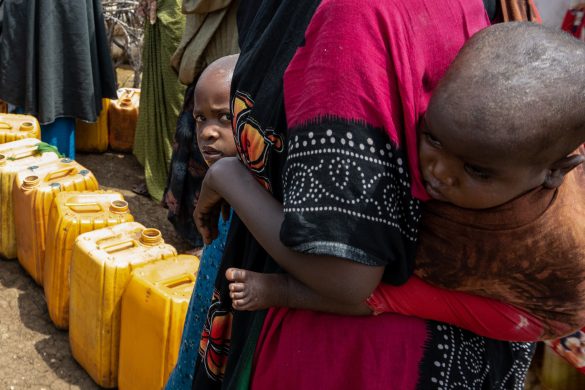Store oversvømmelser ødelægger høsten i det sydlige Somalia, hvor over en million mennesker har akut brug for hjælp og yderligere to millioner er truet af fødevaremangel. Samtidig er FN og Verdensbanken klar med nyt initiativ til 8 mia. dollars, der skal hjælpe Afrikas Horn.
NAIROBI, 31 October 2014 (FAO): After a poor rainy season, parts of southern Somalia are now being hit by severe bouts of floods, further aggravating the already alarming food security situation in the Horn of Africa nation, experts at the Food and Agriculture Organization of the UN (FAO) have warned.
With the devastation of the 2011 famine still fresh in the minds of many, Somalia once again finds itself in a humanitarian crisis.
More than one million people are now in urgent need of assistance – a rise of 20 percent in just six months – while another two million people are experiencing threats to their food security.
Much of Somalia’s agriculture takes place along the Juba and Shebelle rivers, the only perennial streams in Somalia.
They originate in Ethiopia, where over 90 percent of the stream flow is generated and experts fear that swells of floodwaters will ruin the crops.
Early warning signs must lead to action
Latest reports indicate that the worst affected area along the Shebelle River is Belet Weyne town.
Along the Juba River, floods have been reported in Dollow, Jilib and Jamame in Lower Juba, where large areas with crops have been inundated.
“We have a small and critical window of opportunity – we must seize it now if we want to avoid going the same way as four years ago,” said Luca Alinovi, acting Head of Office, FAO Somalia.
Close to 260 000 people died in the 2010-2012 famine in Eastern Africa – more than half of those were children under the age of five – which was the result of a severe drought exacerbated by inadequate humanitarian assistance and poor humanitarian access.
Many current food security indicators across Somalia resemble or are worse than those seen in the pre-famine period in 2010.
“If we’ve learned anything from the devastation of the 2011 famine, it’s that early warning signs must lead to immediate action,” said Bukar Tijani, FAO Assistant Director-General and Regional Representative for Africa.
“We know from experience that quick responses to early warnings are crucial to prevent disaster and are less costly than emergency responses to full-blown humanitarian crisis,” he added.
Cash-for-Work
With resources currently available, FAO will be able to assist 35 000 families (some 210 000 people) throughout the current Deyr – the country’s second annual rainy season – which is being used to support livestock redistribution, expand livestock vaccination drives, provide fishing and agricultural inputs and extend cash-for-work programs.
As part of its current activities, FAO is distributing vouchers to close to 22 500 families for the purchase of some 4 000 tonnes of locally-sourced seeds to help farmers produce a better January harvest.
But another $49 million is needed to extend assistance to a total of 58 000 at-risk households (some 350 000 people) and continue to support those families throughout the first half of 2015.
This is done through Cash-for-Work opportunities, improved agricultural inputs for farming households, redistribution of livestock for destitute pastoralists and agropastoralists and distribution of basic supplies for inland fishing in riverine areas. There is also a need to expand livestock treatment and vaccination campaigns to another 8 million animals (from the current 2 million) to ensure herds can better withstand diseases associated with poor body conditions following periods of prolonged drought.
Roots of the crisis
Poor rains and floods have affected cereal and livestock production across Somalia, while ongoing conflicts continue to disrupt trade routes, thus driving up food prices.
As a result, cereal production has fallen 30 percent below the five-year average and cereal prices quadrupled in parts of the country between January and July 2014.
FAO’s efforts focus on rural areas in South-central Somalia that are facing food crisis and humanitarian emergency conditions.
“The time is now for the international community to step up and prevent another catastrophe in Somalia,” urged Tijani.
New $8 billion initiative
Earlier this week, United Nations Secretary-General Ban Ki-moon announced a new $8 billion development initiative aimed at boosting economic growth, reducing poverty and spurring business activity across the African region’s eight countries – Djibouti, Eritrea, Ethiopia, Kenya, Somalia, South Sudan, Sudan and Uganda.
“The countries of the Horn of Africa are making important yet unheralded progress in economic growth and political stability. Now is a crucial moment to support those efforts, end the cycles of conflict and poverty, and move from fragility to sustainability,” Secretary-General Ban Ki-moon declared in a press release.
Three million people in need
From a humanitarian perspective, some of the countries also find themselves in a precarious situation.
A recent UN humanitarian report on Somalia, for instance, indicated that more than three million people in the country are now in need of assistance – up 20 per cent compared to six months ago.
“This new financing represents a major new opportunity for the people of the Horn of Africa to make sure they get access to clean water, nutritious food, health care, education, and jobs,” said World Bank President Jim Yong Kim, as he pledged his Group’s $1.8 billion for regional cross-border activities aimed at boosting overall economic development.
“There is greater opportunity now for the Horn of Africa to break free from its cycles of drought, food insecurity, water insecurity, and conflict by building up regional security, generating a peace dividend, especially among young women and men, and spurring more cross-border cooperation,” the World Bank President said.














